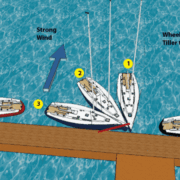How to gybe a sailboat single handed
I do this all the time, but I was out with a friend the other day and he was asking me to lead him through the details. I thought it was obvious but apparently not.
Oh – and if you like this little tip and it helps – please LIKE it and LIKE us over there ——->
Thanks – it encourages us to write more tips.
So here is how to gybe a sailboat when you are operating single handed.

During a gybe, the aft end of the boat turns through the wind. After a gybe the sails are on the opposite side of the boat. Care must be taken, a gybe can be dangerous in higher winds.
First realise this that when you gybe you are usually starting out on about 120 degs off the wind and you are going to gybe to the other side – again to about 120 degrees off the wind. Why 120 degrees – it’s because it is about the most efficient point to keep both sails full – any further down wind and you start to shadow the head sail with the mainsail. And besides if you have taken our Electronic Navigation course, you’ll know that 120 degrees is faster speed towards a downwind destination than aiming 180 right at it – why – that’s another topic covered in depth in our Electronic Navigation course.
Anyway back on topic: 120 deg downwind apparent wind is approximately 135 deg true wind angle downwind (see Basic Sail Trim Course) which is 45 degs off the true downwind angle. You’ll be gybing to 45 on the other side, so a gybe is a 90-degree turn.
This is important to know so that you set a goal heading prior to the gybe. Pick a house, tree, cloud, something that you want to be aiming at when you come out of the gybe.
If you have an autopilot, turn on auto.
Right – so next thing to do is to set up your headsail. Take the lazy sheet onto it’s winch and crank on it decently hard and cleat off. You’re not cranking the sail through, you just want tension on the lazy sheet. You must do this so that the headsail does not wrap around the front of the forestay whilst you are managing other things.
Next – set up the main sheet. Crank in on the mainsheet to bring the mainsail towards the centerline. Leave the locking cleat open so that you will be able to let the main out fast as it comes over.
Ok you’re ready – check for traffic.
If your auto-pilot is on, tap the 10 deg button 9 times in the direction of the gybe (90 degrees – remember). If you don’t have an auto-pilot then turn the wheel/tiller a tiny bit and apply the wheel or tiller lock. Call out to yourself “Gybe-Ho” (that’s optional).
Man the mainsheet (leave the headsail alone, it will do its own job). As the boat comes around, you will feel the mainsheet get even easier to bring to center, do that. As soon as the mainsail comes across you must let the mainsheet out as fast as possible. This will prevent rounding up and excessive heeling of the boat. Lock the mainsheet cleat clutch as soon as the mainsail is out. Now get to the wheel or tiller and straighten the boat out on course.
Now release the windward headsail sheet and let the already prepared leeward sheet pick up the tension on its own. You’ll probably need to trim it in a bit. The more you originally bought in the lazy sheet at the start, the less you will need to trim now.
Easy Peasy!
Good tip? Please LIKE us and consider becoming a NauticEd student – we start you out with two free courses when you sign up for free here.







